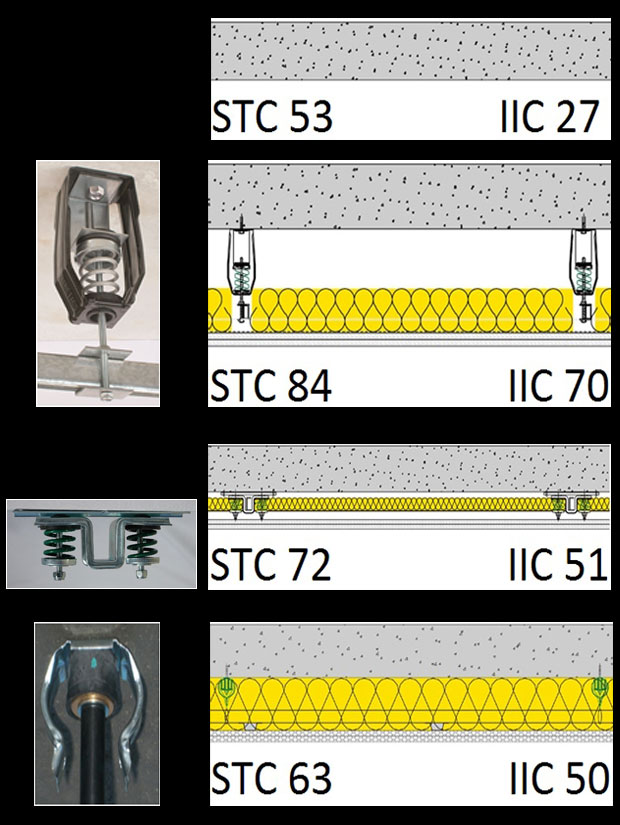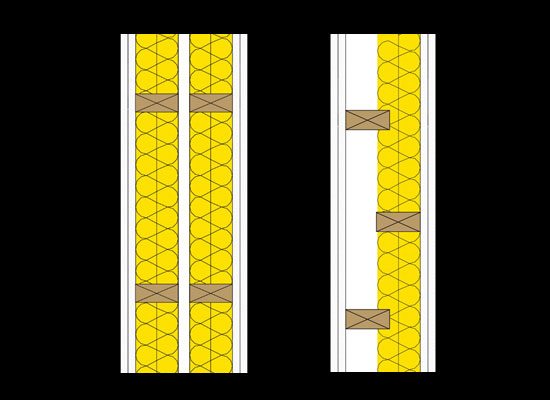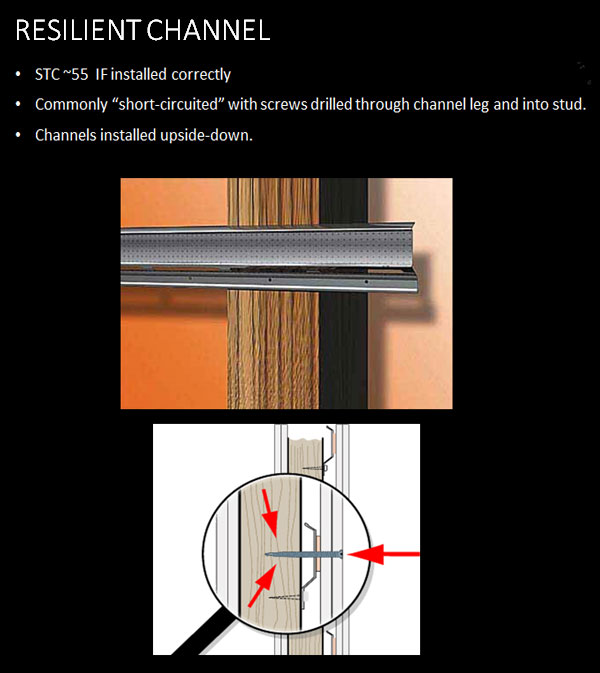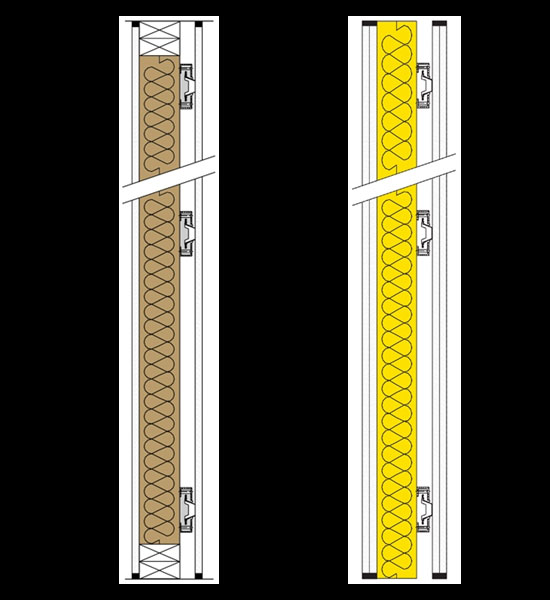Noise Control and Isolation for Multi-Family/Mixed Use Construction
Concrete Construction: Ceilings
Resilient isolation hangers that suspend drywall ceilings greatly improve STC and IIC.
Spring hangers. Just as with wood frame hangers, spring coil hangers provide the best performance when adding noise control under a concrete deck.

Images courtesy of Kinetics Noise Control
Ceiling noise control options for concrete construction
Top: No sound isolation system
Second from top: Addition of 1 in. deflection coil to a bare concrete ceiling slab increased STC and IIC from 53 and 27 to 84 and 70 respectively.
Third from the top: ½ in. deflection coil spring.
Bottom: Low profile easy to install neoprene hanger supports one or more layers of gypsum board below concrete slab.
NB drawings are not at the same scale
Fiberglass or neoprene hangers. These are lower cost, labor saving, non-corrosive and effective in many applications. Some products can support heavy ceilings of gypsum board and plaster. Various attachment methods allow for installation on a variety of ceiling structures, including attachment directly into concrete.
Stud Wall Design
In addition to obtaining increased STC and IIC values in floors and ceiling by specifying assemblies that include resilient isolation products, design professionals can address the design of stud walls. A single stud wall with a single gypsum board on each side has a low STC of 33. By rethinking the single stud design and adding resilient isolation products and gypsum board layers STC can be doubled.

Drawings courtesy of Kinetics Noise Control
Double stud construction, left, has STC 63 and wide wall footprint. Staggered stud construction, right, has a lower STC 53 because a common base plate for studs transmits sound.
The two basic approaches to increasing sound attenuation in stud walls are designing double and staggered stud configurations; and using resilient isolation clips and channels, pads and wall braces.
Double Stud Wall
Double 2 x 4 stud wall with two layers of 5/8 in. gypsum board each side, provides STC 63 and a wall footprint 10-3/4-in.-deep. While effective for high STC, the two walls take additional floor space and have a higher material cost than single stud construction.
Staggered Stud
While much less effective than double stud construction due to common base plates, which transmit sound, staggered stud construction takes less floor space. Staggered stud construction, 2 x 4 on common 2 x 6 base and top plates with two layers of 5/8-in gypsum wallboard on both sides has STC 53. Its wall footprint is 8-1/2-in. deep.
Resilient Channel
For many years, walls and ceiling noise control was handled by installing resilient channel often referred to as RC. This continuous metal angle is attached to a stud on one side and the drywall on the other. While commonly used in many “noise control” assemblies, studies have indicated that the channel is more often than not installed either upside down or is acoustically short circuited by the accidental driving of a screw from the drywall into the wall stud.

Image courtesy of Kinetics Noise Control
Resilient channels should be installed correctly. Resilient channels are often installed upside down, above, or are the wrong type. Another common problem is “short circuiting” when screws are driven through the channel leg into the stud
Resilient Clip for Single Stud
When added to single stud construction, resilient sound isolation clips offer low-cost, space saving noise control. Attached to wall studs they can provide an STC range of 57 to 63 and secure a drywall furring channel. One or more layers of gypsum board are hung to the furring channel using common construction practices. They offer higher STC values than resilient channels. Another advantage is that installers will not inadvertently screw through the "resilient" leg of the channel into the joist or stud. This feature cannot be underestimated given the frequent, unknown occurrences where resilient channel is accidentally rendered ineffective because it is hard-attached.

Images courtesy of Kinetics Noise Control
Isolation clip design and construction for single stud walls provide STC 57 (with single layer of gypsum board) and STC 61 (with double layer of gypsum board). For double stud construction and double layer of gypsum board with isolation clip, STC is 63. For single stud with no isolation clip, STC is 33.









